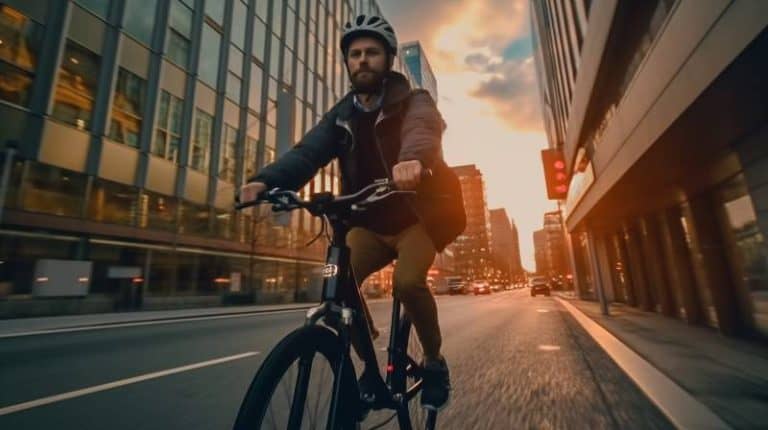How It Works: Reducing Traffic Congestion With E-bikes
Hey there, Tom Kitti here from Electrik Living! As a strong believer in sustainable living and eco-friendly transportation, I’m excited to share with you how e-bikes can revolutionize the way we commute and help combat the growing problem of traffic congestion in our cities. As the founder of Electrik Living, my mission is to empower people like you to make the switch to greener alternatives, and e-bikes are a fantastic place to start!
Key Takeaways
- E-bikes can significantly reduce traffic congestion and improve urban mobility
- Switching from cars to e-bikes benefits the environment and personal health
- Cities must invest in e-bike-friendly infrastructure and promote adoption
How Electric Bicycles Can Alleviate Traffic Congestion and Enhance Urban Mobility
Picture this: you’re stuck in bumper-to-bumper traffic, watching the minutes tick by as you’re late for work once again. Sound familiar? Traffic congestion is a daily struggle for many urban dwellers, leading to increased stress, wasted time, and harmful emissions. But what if I told you there’s a solution that’s not only eco-friendly but also a blast to ride?
Enter the e-bike! These electric-powered bicycles are taking cities by storm, offering a convenient, efficient, and fun way to get around. In this article, we’ll explore how e-bikes can help alleviate traffic congestion and improve urban mobility, all while promoting a healthier lifestyle and a cleaner environment.
The Benefits of E-Bikes in Urban Commuting
Let’s dive into the incredible benefits of e-bikes for urban commuting:
Environmentally friendly alternative to cars
- E-bikes produce zero emissions, significantly reducing your carbon footprint
- By choosing an e-bike over a car, you’re contributing to a cleaner and healthier city environment
Efficient and cost-effective mode of transportation
- Motor-assisted propulsion allows you to cover longer distances and tackle challenging terrains with ease
- E-bikes are time-saving and convenient for daily commutes
- Lower maintenance and operating costs compared to cars
Promoting physical activity and healthy lifestyles
- Riding an e-bike incorporates exercise into your daily routine
- Reduces sedentary behavior and associated health risks
By embracing e-bikes, you not only help reduce traffic congestion but also contribute to a greener, healthier future for yourself and your city!
E-Bikes as a Solution to Traffic Congestion
Now, let’s talk about how e-bikes can be a game-changer in tackling traffic congestion:
Reducing the number of cars on the road
- Encouraging commuters to switch from cars to e-bikes
- Decreased traffic congestion and improved traffic flow
Efficient utilization of urban space
- E-bikes require less space on the road compared to cars
- Maneuverability in dense traffic and accessibility to bicycle lanes and paths
Integration with public transportation systems
- E-bikes as a last-mile solution for commuters
- Enhancing overall mobility and accessibility in urban areas
By integrating e-bikes into our daily commutes and urban transportation systems, we can create a more efficient, sustainable, and livable city for everyone.
Real-World Examples and Case Studies
Don’t just take my word for it! Let’s look at some real-world examples of cities that have successfully implemented e-bike programs:
Successful implementation of e-bike programs in cities worldwide
- Cities with high e-bike adoption rates and their impact on traffic congestion
- Lessons learned from cities that have successfully integrated e-bikes into their transportation systems
Innovative e-bike sharing programs and their effectiveness
- Examples of successful e-bike sharing initiatives
- The role of e-bike sharing in promoting sustainable urban mobility
These case studies demonstrate the tangible benefits of e-bikes in reducing traffic congestion and improving the quality of life in urban areas.

The Future of E-Bikes and Smart City Integration
As technology advances, so do the possibilities for e-bikes and their integration into smart city ecosystems:
Advancements in e-bike technology and design
- Improvements in battery life, range, and charging infrastructure
- Integration of smart features and connectivity in e-bikes
E-bikes as part of the smart city ecosystem
- The role of e-bikes in the development of sustainable and connected cities
- Collaboration between e-bike manufacturers, city planners, and technology providers
By embracing these advancements and integrating e-bikes into our smart city planning, we can create a more efficient, sustainable, and enjoyable urban environment for generations to come.
Overcoming Challenges and Promoting E-Bike Adoption
Of course, transitioning to e-bikes isn’t without its challenges. Here’s how we can overcome them and promote widespread adoption:
Investing in e-bike-friendly infrastructure
- Expanding and improving bicycle lanes and paths
- Installing charging stations and parking facilities
Addressing safety concerns and public perception
- Implementing regulations and safety guidelines for e-bike riders
- Educating the public about the benefits and proper use of e-bikes
Government incentives and policies to encourage e-bike adoption
- Subsidies and tax credits for e-bike purchases
- Integrating e-bikes into sustainable transportation plans
By addressing these challenges head-on and promoting e-bike adoption through infrastructure, education, and incentives, we can create a more welcoming environment for this eco-friendly mode of transportation.

FAQs
How much money can I save by switching from a car to an e-bike for my daily commute?
Switching from a car to an e-bike can save you a significant amount of money in the long run. By eliminating costs such as gas, parking, and car maintenance, you can easily save hundreds or even thousands of dollars per year. E-bikes are much more affordable to operate and maintain compared to cars, making them a cost-effective choice for daily commutes.
Are e-bikes safe to ride in urban areas with heavy traffic?
E-bikes can be safe to ride in urban areas with heavy traffic when riders follow proper safety guidelines and traffic laws. It’s essential to wear a helmet, use designated bike lanes when available, and be aware of your surroundings at all times. Many cities are also investing in e-bike-friendly infrastructure, such as protected bike lanes, to ensure a safer riding experience for e-bike users.
How far can I travel on a single charge with an e-bike?
The range of an e-bike on a single charge varies depending on factors such as the battery capacity, motor power, terrain, and rider weight. On average, most e-bikes can travel between 20 to 50 miles on a single charge. However, some high-end models with larger batteries can even reach ranges of up to 100 miles. It’s important to consider your daily commute distance when choosing an e-bike to ensure it meets your needs.
Do I need a special license or insurance to ride an e-bike?
In most cases, you do not need a special license or insurance to ride an e-bike. However, laws and regulations regarding e-bikes can vary by country, state, or city. It’s crucial to familiarize yourself with the local laws and requirements for e-bike usage in your area. Some regions may have age restrictions, speed limits, or specific rules for e-bike operation on public roads or trails.
How can I find the best e-bike for my needs and budget?
To find the best e-bike for your needs and budget, start by assessing your daily commute requirements, such as distance, terrain, and cargo capacity. Consider your budget and prioritize the features that matter most to you, such as battery range, motor power, or additional accessories. Research different e-bike brands and models read customer reviews, and compare prices. You can also visit local e-bike shops or attend e-bike events to test-ride various models and get expert advice from professionals in the field.
What do studies show about the effectiveness of e-scooters and e-bikes in reducing congestion?
Studies have found that e-scooters and e-bikes can help reduce traffic congestion by offering an alternative to traditional cars for short trips, thus easing the burden on road networks.
How can data science and policy labs contribute to addressing traffic congestion and carbon emissions?
Data science and policy labs can analyze transportation data to better understand traffic patterns and develop policies that promote the use of sustainable modes like e-bikes to reduce both traffic congestion and carbon emissions.
Are there any restrictions on the use of e-scooters and e-bikes in cities?
Some cities have imposed bans or regulations on the use of e-scooters and e-bikes to address safety concerns and ensure they are integrated effectively into the existing transportation infrastructure.
Conclusion
At Electrik Living, we’re here to help you navigate the exciting world of e-bikes and sustainable transportation. If you have any questions, or concerns, or simply want to learn more about how e-bikes can transform your daily commute, don’t hesitate to reach out to our knowledgeable team. Whether you need assistance in choosing the right e-bike model, understanding local regulations, or planning your e-bike-friendly route, we’re here to provide the support and guidance you need. Contact us today through our website, and let’s work together to create a greener, more sustainable future for urban mobility.






